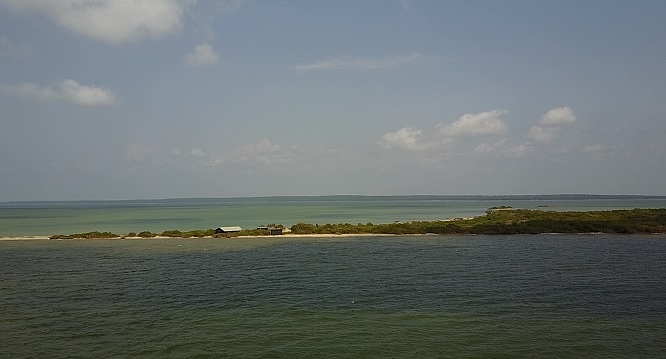Kite Spots in Sri Lanka – Complete 2025 Guide 🌴🪁
Top kitesurf locationsSri Lanka is not only a tropical island of palm trees, tea fields and wildlife — it’s also one of the most exciting kite destinations in Asia. With steady wind, warm water and a mix of lagoons, islands and wave spots, the country has become a paradise for riders of every level.
In this guide you’ll discover the best kite spots in Sri Lanka, from the famous Kalpitiya Lagoon to hidden gems like Indo/Ippantivu and the remote Adam’s Bridge in Mannar. Whether you’re searching for flat lagoons, ocean waves or long downwinders, these kite locations will help you decide where to kitesurf in Sri Lanka in 2025.
If you want to learn or join kite trips, our kite school in Kalpitiya is the perfect base. From here we organise daily lessons, downwinds and boat trips to all the main spots.
Quick Comparison Table
| Spot | Best season | Water | Level | Wind | Notes / Highlights |
|---|---|---|---|---|---|
| Kalpitiya Lagoon | Summer & Winter | Flat, shallow & deep areas | Beginners only | Cross off-shore | Main learning spot in Sri Lanka. Ideal for foiling thanks to deeper areas. Base of Margarita Kite School with rescue boat & walkie-talkies. |
| Kappalady Lagoon | Mainly Summer, some Winter days with good wind direction | Flat, very shallow | Beginners | Cross on-shore | Small lagoon, can feel crowded with 20+ riders. Works mostly in summer. Limited in winter. Not ideal for wingfoil. |
| Dream Spot | Summer & Winter | Flat & choppy | Intermediate | Cross off-shore | 15–20 min boat ride. Spacious and safe. Great for progression. Popular downwind to Mini Vella in summer. |
| Vella Island | Summer only | Flat with lagoons (2025) | Advanced only | Off-shore | Legendary downwinds. Due to off-shore wind conditions, it is for advanced riders only. Bring 7–9m kites in summer. |
| Ippantivu (Mini Vella) | Summer only | Flat | Advanced | Off-shore | Quiet spot in Puttalam Lagoon. Sandbar shrinking in 2025 – check conditions before going. |
| Navy Point | Winter + Summer 2025 | Flat | Advanced | Off-shore | Winter: start for downwind to Dream Spot. Summer: ending point for downwind from Vella Island. |
| Donkey Point | Summer only | Waves (small–medium) | Intermediate – Advanced | Cross on-shore | Popular wave spot for strapless riders. Keep distance from the nearby military base. |
| Adam’s Bridge (Mannar) | Summer only | Mixed / exposed | Advanced only | Cross | Remote adventure. Very few facilities. Expedition-style trip for experienced kiters. |
| Kite sizes: Summer 7–12m, Winter 10–14m (depending on rider weight). Safety: always kite with rescue boat support. Lessons: IKO-certified schools with walkie-talkies ensure faster progression. | |||||
Kalpitiya Lagoon – Main Learning Spot
Kalpitiya Lagoon is the most popular kite spot in Sri Lanka and the safest location to learn. Wide, shallow, and flat, it’s perfect for beginners and progression. Our kite school is based right on the lagoon, so it’s our daily playground. With boat rescue support always on hand, this spot offers a safe and reliable environment for your kite lessons.
Pro tip: The lagoon floor has some seashells, so wearing water shoes is recommended. At Margarita Kite School we provide water shoes, helmets, and buoyancy aids to make learning safer and more comfortable.
How to get there: Only 5 minutes by tuk tuk from Kalpitiya town.
👉 Discover our kite courses in Kalpitiya Lagoon.

Kappalady Lagoon – Small but Reliable
Kappalady is a small lagoon with flat, shallow water that works mainly in the summer season. In winter, the wind direction is less reliable compared to Kalpitiya Lagoon. It’s a popular kite spot for beginners, and you’ll find several kite schools based here. During summer we sometimes organise downwinders from Kappalady to Kalpitiya, which are a great experience.
The lagoon is ideal for learning, but due to its small size it feels crowded with more than 20 riders. It’s also not suitable for wingfoiling because of the limited space.
Pro tip: The best time to kite in Kappalady is around midday, when many schools take a break and the lagoon becomes quieter.
How to get there: From Kalpitiya town, take a tuk tuk south towards Kappalady. The ride takes about 30 minutes, and you can strap your kiteboard on the roof.

Dream Spot – All-Year Playground
Dream Spot is one of the most popular kite trips and kite locations near Kalpitiya. A 15–20 minute boat ride takes you to this spacious lagoon with both flat and slightly choppy sections, making it versatile and fun.
The spot works in both summer and winter seasons and is best suited for intermediate riders and above.
Pro tip: In summer, a downwinder from Dream Spot to Mini Vella through Puttalam Lagoon is highly recommended — a true adventure for experienced kiters.
How to get there: From our kite center at Margarita Kite School, it’s a short boat ride north. You can also reach it by 4×4 jeep from Kalpitiya beach through Dutch Bay.
👉 Join our Dream Spot kite trips.

Vella Island – Legendary Downwind
Vella Island is one of the most legendary kite destinations in Asia. Our team can take you to this unspoiled island where the wind is stronger, steady, and completely side-shore — ideal for endless speed runs and freestyle.
Because of the off-shore wind, it’s recommended only for advanced riders. In summer 2025, small flat-water lagoons also formed inside the island, adding variety and making it a unique kite location to explore.
Pro tip: Vella works best in summer. The wind is strong, so bring smaller kites (7–9m).
How to get there: A 45-minute boat ride from Kalpitiya Lagoon.
👉 Don’t miss our Vella Island trips.

Ippantivu (Mini Vella) – Secret Spot
Also known as Mini Vella, this is a hidden kite spot inside Puttalam Lagoon. Thanks to the venturi effect, the wind here often feels stronger than in other locations.
It’s suitable only for advanced riders. The sandbar has been shrinking year after year, and by 2025 it is almost gone, so conditions may vary.
Pro tip: Always check conditions with local kite schools before planning a trip here.
How to get there: From our kite center at Margarita Kite School, you can reach Ippantivu in about 25 minutes by boat.

Navy Point – Flat-Water Alternative
Navy Point is located at the end of Dutch Bay. It used to work only in winter, but since 2025 a new flat-water area also works in summer, making it more versatile than before.
This is an advanced kite spot due to the off-shore wind conditions, so riders should always go with boat support.
Pro tip: In winter, Navy Point is the perfect starting point for a downwinder to Dream Spot. In summer, it’s often used as the final stop for a downwind from Vella Island.
How to get there: From Kalpitiya Lagoon, it’s about a 30-minute boat ride north. You can also reach it by 4×4 jeep from Kalpitiya beach through Dutch Bay, passing by Dream Spot on the way.

Donkey Point – Waves and Ocean Riding
Located about 10 km south of Kalpitiya, Donkey Point is the most popular wave location in the area. With small to medium waves and steady cross on-shore wind, it’s the go-to spot for surfboard and strapless riders.
It is suitable for intermediate to advanced riders.
Pro tip: Donkey Point is also perfect for wingfoiling. Just keep a safe distance from the nearby military base when riding close to shore.
How to get there: Around 20 minutes south from Kalpitiya town by car, tuk tuk or even bike.

Adam’s Bridge (Mannar) – Remote Adventure
Adam’s Bridge is a chain of sandbanks and small islands that once connected Sri Lanka to India. Remote, wild and windy, it stands out as one of the most adventurous kite destinations in Sri Lanka.
This spot is only for advanced and adventurous riders, as conditions are exposed and there is no infrastructure nearby.
Pro tip: Go well-prepared with logistics, food, and safety support. A trip to Adam’s Bridge is more of an expedition than a regular kite session.
How to get there: From Kalpitiya, the best route is via the Anuradhapura road to Mannar. Adam’s Bridge is located at the very end of the Mannar peninsula.

FAQ – Kitesurfing in Sri Lanka
Can I kitesurf in South Sri Lanka?
Yes, you can enjoy some decent kite sessions in the south, although the wind is not as consistent as in Kalpitiya. Most beaches are reef breaks, so it’s recommended only for advanced riders. You also won’t find kite schools in this area. For more details, check our full guide: Kitesurfing in South Sri Lanka.
Is Arugam Bay good for kitesurfing?
Arugam Bay is mainly famous for surfing, but it can also get windy at times. You may have some kite sessions here with side-offshore winds and small waves. Read more in our Arugam Bay kitesurfing guide.
I have only a short visit to Sri Lanka and no time for Kalpitiya. Is it possible to kite in Negombo?
Yes, you can kite on Negombo beach if you are an advanced rider, but watch out for fishing nets near the shore. The Negombo Lagoon is not suitable for kitesurfing. For proper kitesurf lessons, you’ll need to head to Kalpitiya.
I am a beginner. What is the best kite trip I can join?
If you are still a beginner, we can take you to Dream Spot, which is one of the most beginner-friendly kite locations near Kalpitiya.
What are the best kite spots for advanced riders?
For advanced riders, Vella Island is the ultimate choice, with stronger and more consistent wind than most other spots.
I plan to visit Mannar — is there any kite resort up there?
After COVID, unfortunately all kitesurf camps in Mannar shut down. At the moment, there are no kite schools or kite resorts operating in Mannar. If you decide to go, keep in mind you’ll be completely on your own. For a safer and more complete kite experience, it’s best to base yourself in Kalpitiya and join one of our kite packs in Sri Lanka.
Ride with Margarita Kite School
We are based right on Kalpitiya Lagoon, with daily boat trips to Dream Spot, Vella, and Donkey Point. We provide:
-
IKO lessons with walkie-talkie coaching.
-
Rescue boat and beach crew.
-
Trips to all major spots.
-
Accommodation: wooden bungalows, chalets with AC, or a social dorm.
-
Extras: yoga, buffet dinners, and our Sunset Bar.
👉 Plan your trip now:
Conclusion
From shallow lagoons like Kalpitiya and Kappalady to world-class kite locations such as Dream Spot and Vella Island, and the adventurous downwinds to Navy Point and Adam’s Bridge, Sri Lanka offers one of the most complete kitesurf destinations in the world.
No matter if you’re a beginner looking for safe flat water, an intermediate rider chasing progression, or an advanced kiter searching for adventure — here you’ll always find the perfect place to ride.
👉 Come ride with us at Margarita Kite School and experience the best of kitesurfing in Sri Lanka: lessons with IKO instructors, trips to all major spots, and accommodation options for solo travellers, couples or groups.
